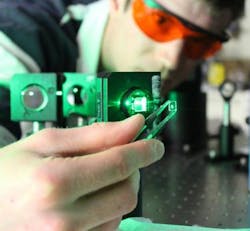Interest in oxide-based semiconductor electronics has grown, fueled largely by the ability to grow atomically precise layers of various oxide materials. One of the most important materials in this burgeoning field is strontium titanate (SrTiO3), a nominally nonmagnetic wide-bandgap semiconductor; researchers at Los Alamos National Laboratory (LANL; Los Alamos, NM), the University of Minnesota (Minneapolis, MN), and Technische Universität Dortmund (Dortmund, Germany) have now found a way to magnetize this material using sub-bandgap (400–500 nm) light, an effect that persists for hours at a time.1 The optically induced and persistent magnetization occurs only when the crystals of SrTiO3 are slightly oxygen-deficient.
"There have been tantalizing hints in recent years that there might be more to SrTiO3 than originally thought," says Scott Crooker, lead scientist of the project at Los Alamos. "When layered with other 'nominally nonmagnetic' oxides, a handful of recent experiments around the world have shown not only superconductivity but also an unexpected magnetism. So that piqued our interest in this material."
Using samples prepared by collaborators in Leighton's group, the researchers used magnetic circular dichroism spectroscopy and superconducting quantum-interference-device (SQUID) magnetometry to show that circularly polarized light can induce an extremely long-lived magnetic moment in SrTiO3 at zero applied magnetic field. These signals appear below 18 K, persist for hours below 10 K, and can be controlled in both magnitude and sign via the circular polarization and wavelength of 400-500 nm light. As such, magnetic patterns can be written into SrTiO3, and subsequently read out using light alone.
"The exciting possibility is to potentially use this to store data in some way," says collaborator Chris Leighton of the University of Minnesota.
REFERENCE:
1. W. D. Rice et al., Nature Materials (2014); doi: 10.1038/nmat3914

